OK - flame away.
But I'm quasi serious here. Why didn't they think about adding a pantograph to the new Viewliner diners? I guess I'm not over the fact that trains come into WAS during meal times, but dining service is disrupted for between 10 and 20 minutes while power is being switched to/from diesel to/from electric. My previous idea to hook up hotel power was completely flamed off the planet because apparently no railroad electric engineer can come up with a single step process to plug a train into hotel power when they disconnect the locomotive. I get all the explanations that were given in that thread, though I don't necessarily agree. So my next brainwave I borrowed came up with this idea. Why not have a pantograph that can be deployed during engine swaps? Have some sort of relay to allow hot swapping of engines so that there is seamless power disruption.
I guess I have eternal hope that this simple, unappreciated nuance can someday be addressed in the future. How long did third rail trains lose power to a given car when the power rail switched from left to right or was missing through a switch or grade crossing? They eventually figured out how to distribute the power from all the pick ups to all the cars without blowing anything up. They can do that here, too.
The obvious other benefits would be that the pantograph could then provide power to the rest of the train so no one is inconvenienced during the power swap.
But I'm quasi serious here. Why didn't they think about adding a pantograph to the new Viewliner diners? I guess I'm not over the fact that trains come into WAS during meal times, but dining service is disrupted for between 10 and 20 minutes while power is being switched to/from diesel to/from electric. My previous idea to hook up hotel power was completely flamed off the planet because apparently no railroad electric engineer can come up with a single step process to plug a train into hotel power when they disconnect the locomotive. I get all the explanations that were given in that thread, though I don't necessarily agree. So my next brainwave I borrowed came up with this idea. Why not have a pantograph that can be deployed during engine swaps? Have some sort of relay to allow hot swapping of engines so that there is seamless power disruption.
I guess I have eternal hope that this simple, unappreciated nuance can someday be addressed in the future. How long did third rail trains lose power to a given car when the power rail switched from left to right or was missing through a switch or grade crossing? They eventually figured out how to distribute the power from all the pick ups to all the cars without blowing anything up. They can do that here, too.
The obvious other benefits would be that the pantograph could then provide power to the rest of the train so no one is inconvenienced during the power swap.
Last edited by a moderator:














































